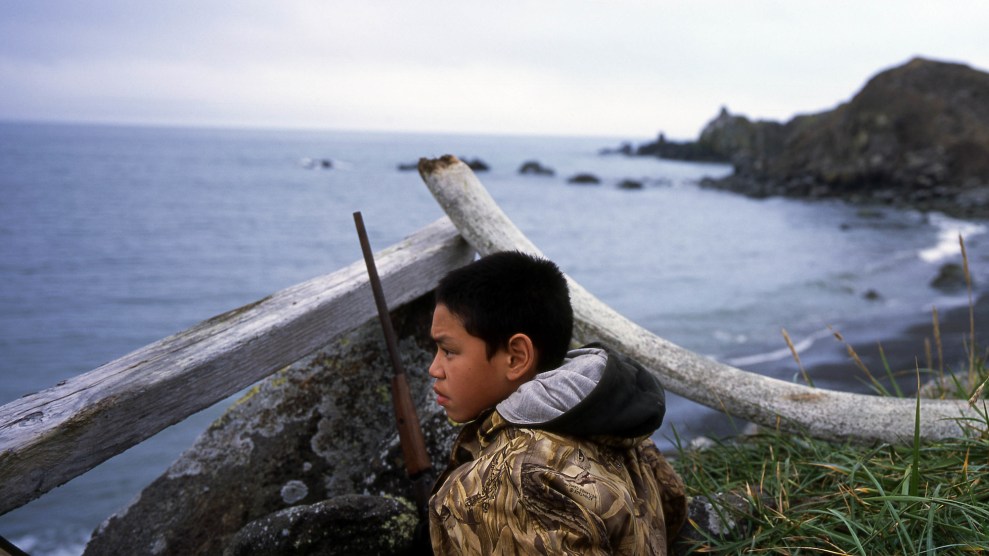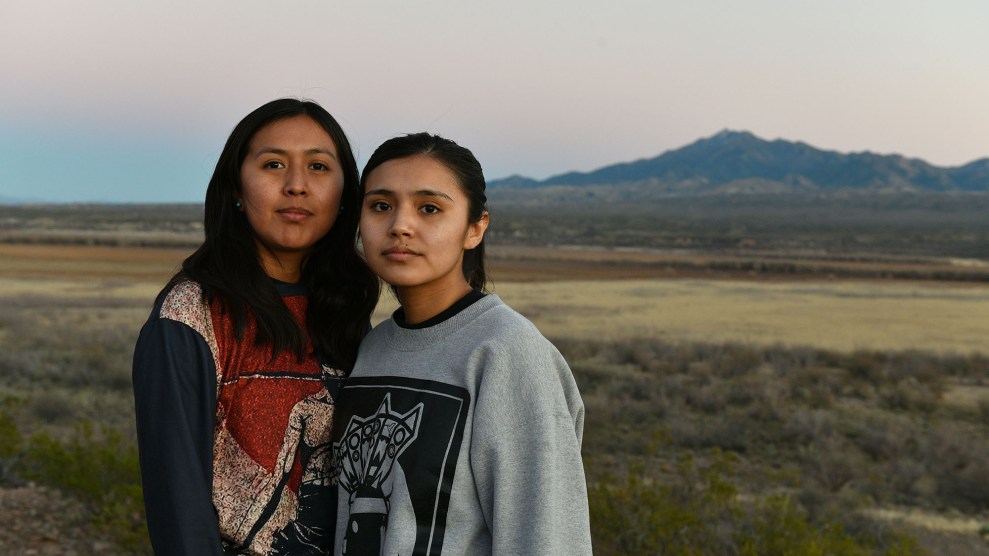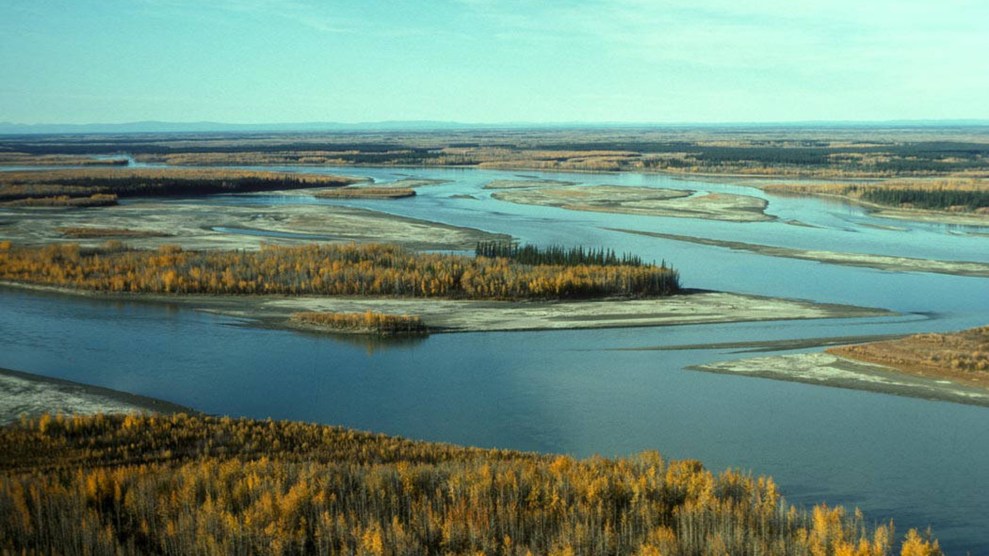
Steven James, 12, waits to hunt gees on St. Lawrence Island.Ann Johansson/Getty
This story was originally published by Inside Climate News and is reproduced here as part of the Climate Desk collaboration.
For over 2,000 years, the Indigenous people known as the Yupik have occupied St. Lawrence Island, a sliver of Alaska that rests in the Bering Sea just below the Arctic Circle and where, on a clear day, it’s said that one can see the coastline of Russia about 40 miles away.
To this day, residents maintain a subsistence lifestyle centered around the region’s fish and wildlife. Growing up on the island, Pangunnaaq Vi Waghiyi absorbed a simple lesson that has been passed down across the generations: “Our elders call the ocean our farm,” she related fondly in a recent phone interview.
But what happens when the ocean, the soil, and the air itself become polluted?
Drawing on her familial roots at the top of the world, Waghiyi has been working with the environmental justice group known as Alaska Community Action on Toxics to help researchers answer those questions.
Now, a newly released review of more than 200 studies has concluded that children from low-income families and families of color are exposed to more neurotoxic chemicals—and experience greater harm from them—than young people from higher-income and white families.
The article, published in the journal Environmental Health Perspectives and based on research by an alliance of scientists, medical professionals, and environmental advocates, including Waghiyi’s group, focuses on a range of harmful chemicals, including lead, particulate matter, pesticides, and phthalates, or substances added to plastics to make them more flexible.
The review notes that those chemicals can affect brain development and cause developmental delays in children—problems that, researchers wrote, can be exacerbated by such factors as poverty, “racist and discriminatory policies and processes such as racial residential segregation, disproportionate citing of polluting sources in communities of color, and government-backed policies to dispossess Native Americans of their lands and cultures.”
The combined research demonstrates that such environmental injustices affect the health of all age groups, the authors write. Yet as noted by the science writer Harriet Washington, they add, “environmental assaults on the developing brain are particularly pernicious because the effects can have lifelong implications.”
“The whole issue is, children are not exposed to one neurotoxicant at a time—it’s many,” said Devon Payne-Sturges, a co-lead author of the article and an associate professor of environmental health sciences at the University of Maryland’s School of Public Health. “And so, you know, policies that allow these exposures to continue are really just stealing children’s future potential. And we wanted to highlight this issue about cumulative exposures and cumulative effects.”
The authors examined 218 studies spanning five decades, most of which focused on exposure to combustion-related air pollution like car exhaust or industrial emissions, which increases the risk of respiratory ailments, heart disease and strokes, or to lead, which can cause developmental delays, neurological problems and behavioral challenges in children.
Beyond the high rates of lead exposure among Black and Hispanic children, the researchers noted that children of color have been exposed to higher levels of the pesticides widely used in agriculture. And Black and Hispanic mothers have been exposed to high levels of phthalates, which interfere with human hormones, they observe.
The authors also summarized how low socioeconomic status has amplified the adverse impact of lead exposure on children’s cognitive functioning to a greater degree than previously believed. And they examined studies in which air pollution exposures were associated with greater adverse effects in terms of lowering IQ scores among children who are from families with low socioeconomic status.
“We found that certain types of adversity or disadvantage really magnify the impact of a particular chemical,” said Tanya Khemet Taiwo, an assistant professor in the Department of Midwifery at Bastyr University in Kenmore, Washington, who was also a lead author of the study.
“That means that if you have equal levels of, say, lead exposure in two children and one comes from a family without any social disadvantage, the actual loss of IQ is greater in that child living in a home where they have some factors of social disadvantage,” Khemet Taiwo said. “And that was something we spent a lot of time struggling with and working on and really digging through.”
The article’s authors say they hope their work will help inspire targeted interventions, shape new policy, and encourage greater investment in efforts to eliminate those health disparities. Their findings also underline the need for a greater emphasis on the role of race when researchers are studying harmful environmental exposures, they add.
“The treatment of race and ethnicity in epidemiological studies deserves as much rigor as exposure and health outcome assessment,” the researchers wrote, adding, “Racial categories must be recognized as social constructions whose meanings are not static, and are the result of racism and racialization.”
Such processes “allocate differential economic, political, social, and even psychological rewards to groups along racial lines and are maintained to preserve status differences,” they noted.
The scientists also pointed to a “conspicuous” lack of studies involving Native American and Indigenous populations, one of the factors driving Waghiyi and her group to assist in such research efforts.
Waghiyi is 64 and a native of Savoonga, the most populous city on St. Lawrence Island with 835 people. She said her community has borne a disproportionate share of the effects of contamination because its diet is still primarily centered on whales, seals, walruses and reindeer.
“Because of where we live in the Arctic, we are some of the most highly contaminated population on the planet because of our reliance on our subsistence foods,” she said.
Ocean currents sweep pollutants up into the Arctic region, Waghiyi explained, and the island is home to an abandoned Cold War-era air base that has been shedding chemicals into the air, soil and water as it decays. The results have been devastating, she said.
“We now know my people have four to 10 times higher PCBs”—polychlorinated biphenyls, chemicals that cause cancer in animals and have other adverse health effects—“than the average American in the Lower 48,” Waghiyi said. “Along with PCBs, we also found pesticides, heavy metals, solvents. Massive fuel spills. Asbestos. Lead. Mercury.”
The activist views the chemicals as “burdens we didn’t create and environmental violence, where we’re being contaminated without our consent.”
Waghiyi, who also serves as a member of the White House Environmental Justice Advisory Council, said her group has helped lead community-based research on the harms of toxic chemicals on Sivungaq, the traditional name for St. Lawrence Island.
Now based in Anchorage, Waghiyi said the research is “my passion because it is so personal and we’re seeing health disparities never seen before in our people.”
In the 1970s, she said, a Yupik elder named Annie Alowa who was working as a health aide began noticing a high incidence of cancer as well as low birth weights, miscarriages and stillbirths in the Northeast Cape, the part of St. Lawrence where Waghiyi grew up. “Early on, she tried to get help for our people for 20 years, and nobody would validate her concerns,” Waghiyi said.
Now Alaska Community Action on Toxics is investigating the legacy contaminants from the military base, persistent organic pollutants like the pesticide mirex and other worrisome substances. Waghiyi said the effects have been multigenerational and, for her, searingly personal.
“Where do I begin?” she said. “My father died of cancer. My mother had a stillborn child after me. She also had heart disease, diabetes, strokes, depression and cancer. We buried my brother of cancer a year ago. I’m a cancer survivor and I’ve had three miscarriages.
“We’re seeing birth defects in our children. We have children being born with no brains. And these are all families associated with the Northeast Cape.”
Change will not come fast enough for her generation, Waghiyi said, but whatever the obstacles, her group will press on for the children. ”My community and leadership are committed to making meaningful change for our future generations,” she said.











